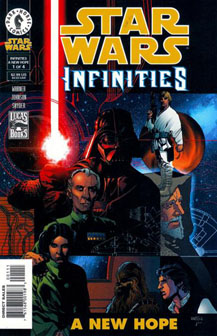Dark Horse’s “The Star Wars,” an adaptation of an early draft of “A New Hope,” caused quite a buzz this past year, but it wasn’t the franchise’s first foray into “Infinities” – alternate stories of what could have been, similar to the old Marvel “What If?” comics. But while “The Star Wars” shows us characters, personalities, worlds, technology and history BEFORE George Lucas had them set in stone, those earlier “Infinities” four-issue series – for “A New Hope,” “The Empire Strikes Back” and “Return of the Jedi” — are different.
These “Infinities” retain the characterizations, motivations and key points of the films, but explored the “butterfly flapping its wings” concept (or “Jurassic Park’s” chaos theory, if you prefer) – if one little thing is different, it can change everything that follows.
In the four-issue “Infinities: A New Hope” (2001), the first of three distinct “Infinities” yarns (“Infinities: Empire” and “Infinities: Jedi” are not sequels to this series, but rather new “what ifs”), 95 percent of “Episode IV” remains intact, as we see in the opening pages. Writer Chris Warner throws a monkey wrench into the end of the film’s narrative when Luke’s proton torpedo explodes prematurely, failing to blow up the Death Star. Han and Luke escape, but Leia is taken prisoner by the Empire.
What follows is an epic story that includes a full five years (!) of Luke training on Dagobah, which is also plenty of time for Leia to be indoctrinated into the Empire – and for Han to remain his same old self, naturally. Presumably, Leia is brainwashed off-page (the Emperor calls it “obedience training”) in the classic “Clockwork Orange” fashion of her eyes being held open by clamps while propaganda plays in an endless loop before her – this trope was most recently used by Hydra on “Marvel’s Agents of S.H.I.E.L.D.” And it was used once on “Lost,” for reasons that were never made totally clear.
But it’s equally chilling when Vader makes his verbal pitch to Leia: Now that the Rebellion has been crushed, a new era of peace can begin, with Leia among the leadership. We don’t get much of Vader’s political views in the classic trilogy, but we do get Anakin’s in “Episode II,” and it fits with his authoritarian/utopian views to say:
“A new age is dawning for the galaxy, an age in which the vast resources at our disposal may be turned to bring about prosperity and wonders undreamed.”
That’s spot-on dialogue from Warner, considering “Infinities: A New Hope” predated “Episode II’s” release.
This new “peaceful” Empire actually makes some provocative (if shallow) concessions to democracy, reinstating the Senate and rotating the capital among worlds. It’s not stated explicitly, but we can imagine the Emperor announcing an end to his emergency powers, thus gaining him the love of many people while he can remain secure in the knowledge that he still controls the government. Vader’s pitch to Leia plays against a backdrop of massive military might surrounding Coruscant, Empire Day parades featuring AT-AT walkers, and Han and Chewie being shot at by stormtroopers on Ord Mantell.
Still, I have no trouble believing that Leia – after her initial failed suicide attempt — would convince herself that she can “fix things from the inside.” In U.S. politics, some people work for change from outside the system, some from within. While the success at Yavin in “A New Hope” propelled Leia to become a confident leader of the Rebel Alliance, it’s understandable that she would try a new tactic when captured by Vader in “Infinities: A New Hope.” Then she would grow to believe in the Empire the more time she spends in the inner sanctum and away from the daily lives of citizens.
Warner, in what is unfortunately his only “Star Wars” writing credit (he also drew a few covers), blends humor and action like the films do, from Luke wryly telling Han “I figured you didn’t come all this way for Yoda’s stew,” to Yoda playfully manipulating Admiral Tarkin and using the Death Star (excuse me, “Justice Star”) to blow up Super Star Destroyers in his playful fashion.
Meanwhile, artists Drew Johnson (Issues 1-2) and Al Rio (Issues 3-4) do a wonderful job showing us scenes we could only stage with our action figures (Luke taking on Imperial guards) or in our imaginations while reading about the too-ambitious early drafts of “Return of the Jedi” (a massive battle on Coruscant that culminates with the Death Star crashing into the planet’s surface).
Come to think of it, Warner’s story has a sprawling nature to it similar to Lucas’ early drafts of “A New Hope.” Eventually, Lucas realized he had three films on his hands, plus the backstory for three more. And even when he got to “Empire” and “Jedi,” those too were overwritten in early drafts. Being a comic book rather than a movie, “Infinities: A New Hope” allows for the ambitious sprawl, but it also retains the beats and characterizations we’re familiar with and gives us a full, nuanced story that transcends its gimmick.


